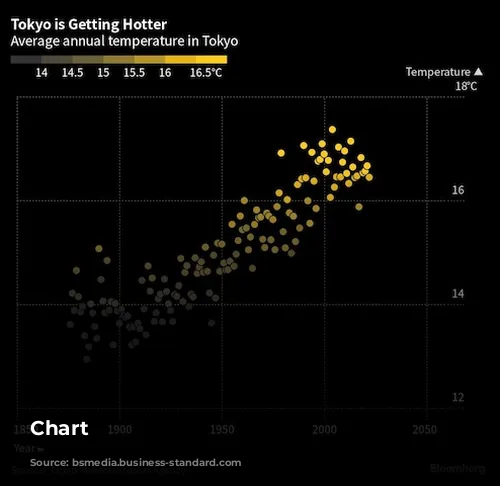Japan is sweltering under an intense heatwave, with temperatures soaring far above seasonal averages. This extreme weather event highlights the country’s vulnerability to climate change, especially with its rapidly aging population.
A Nation Under the Scorch
The mercury in central Tokyo has skyrocketed, reaching almost 9°C (16°F) above the typical temperature for this time of year. The heatwave, a stark reminder of the global warming trend, is pushing temperatures to unprecedented levels. In response to this scorching heat, Japan’s government has issued urgent heatstroke warnings, urging citizens to stay indoors, avoid strenuous activities, and check on vulnerable neighbors.
Japan’s aging population, with almost 30% of its citizens over 65, makes it particularly susceptible to extreme heat. The elderly, along with infants and those with pre-existing health conditions, are at a higher risk of experiencing heatstroke.
This ongoing heatwave underscores the critical need for proactive measures to protect vulnerable populations from the escalating dangers of extreme temperatures.
A Trend That Won’t Cool Down
Historical data reveals that Tokyo has been experiencing a steady warming trend over decades. The average annual temperature has climbed by approximately 3°C over the past century. This year’s exceptional heatwave has amplified this trend, pushing temperatures to new highs.
On Monday, the maximum temperature in central Tokyo reached a staggering 36.2°C, a full 7°C above the average for this time of year. This alarming trend has been ongoing, with last Wednesday’s temperature soaring to 37.5°C, an astounding 8.9°C above the seasonal average.
This heatwave serves as a stark warning of the accelerating impacts of climate change.
A Concrete Jungle in the Heat
Besides the global warming trend, Tokyo is also grappling with the urban heat island phenomenon. This urban heat island effect occurs when densely populated cities, dominated by buildings and roads, trap heat, leading to higher temperatures compared to surrounding areas.
The combination of climate change and the urban heat island effect has created a dangerous cocktail for Tokyo’s inhabitants.
Global Concerns and Local Solutions
Japan is not alone in facing rising temperatures. Europe is also experiencing record-breaking heat, with the Italian islands of Sicily and Sardinia expected to surpass 48°C this month. However, the situation is particularly concerning in Japan due to its aging population. In 2020, a staggering 86% of heatwave-related deaths in Japan involved individuals over the age of 65.
In response to the growing threat of heatstroke, Japan’s cabinet has approved a plan to reduce heatstroke-related casualties. This plan includes measures like encouraging local municipalities to establish air-conditioned cooling shelters. For those working outdoors, such as construction workers, clothing equipped with built-in fans has become increasingly common.
These initiatives highlight the government’s efforts to adapt to the changing climate and protect its citizens from the dangers of extreme heat.
Living in an Uncomfortable World
Days with temperatures exceeding 35°C are classified as “moushobi” in Japanese, meaning “extremely hot day.” These days have become increasingly common in recent decades. The urban heat island effect can be so intense that buildings fail to cool down at night, forcing residents to rely on air conditioning throughout the evening. Those who cannot afford air conditioning struggle to sleep, leading to increased stress and physiological impacts.
These consequences of the extreme heat highlight the need for affordable and accessible cooling solutions, especially for vulnerable populations.
A Call for Action
The prolonged heat and its consequences, such as increased stress and health risks, underscore the urgency of addressing climate change. It is crucial for governments and communities to collaborate to implement effective measures to mitigate the effects of climate change and protect vulnerable populations.
These drastic changes in temperature serve as a powerful reminder of the need to prioritize environmental sustainability and develop strategies to adapt to the changing climate.


